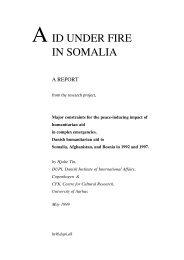wfp, food aid and local survival in guinea-bissau, 1998-99 - Nina ...
wfp, food aid and local survival in guinea-bissau, 1998-99 - Nina ...
wfp, food aid and local survival in guinea-bissau, 1998-99 - Nina ...
Create successful ePaper yourself
Turn your PDF publications into a flip-book with our unique Google optimized e-Paper software.
Hjalte T<strong>in</strong> : Food Aid <strong>in</strong> Gu<strong>in</strong>ea-Bissau <strong>1<strong>99</strong>8</strong>-<strong>99</strong>. June 2001 ; page 21<br />
starvation.” (Donor Report Gu<strong>in</strong>ea-Bissau,1<strong>99</strong>9) But does this assertion hold water?<br />
Available <strong>in</strong>formation on the nutritional impact of the <strong>food</strong> <strong>aid</strong> is rudimentary <strong>and</strong> does<br />
not permit more than a discussion of the average impact of the total <strong>food</strong> <strong>aid</strong>. Of course,<br />
certa<strong>in</strong> groups received more <strong>and</strong> others less than the average, but without data –one<br />
excemption is mentioned below – a more detailed assessment is hardly justified.<br />
Table 2 below makes clear the limited contribution of <strong>food</strong> <strong>aid</strong> to the total amount of<br />
available <strong>food</strong>. Accord<strong>in</strong>g to CILSS, a committee monitor<strong>in</strong>g <strong>food</strong> security for FAO <strong>in</strong><br />
the Sahel region (Gu<strong>in</strong>ea-Bissau was <strong>in</strong>cluded <strong>in</strong> the 1980s for reasons of <strong>food</strong> <strong>aid</strong><br />
politics), 14.490 tons <strong>food</strong> <strong>aid</strong> was imported Nov 1 1<strong>99</strong>7-Oct 31 1<strong>99</strong>9, (2.000 tons lower<br />
than the WFP figure). Dur<strong>in</strong>g the war <strong>local</strong> production of <strong>food</strong> only dropped 13%, <strong>and</strong><br />
rice production actually <strong>in</strong>creased 8% because many of the displaced persons took part<br />
<strong>in</strong> rice cultivation <strong>in</strong> the villages where they found shelter. It is also noteworthy that<br />
commerical <strong>food</strong> import was 5 to 10 times higher than <strong>food</strong> <strong>aid</strong> import. The <strong>1<strong>99</strong>8</strong>/<strong>99</strong><br />
import was particular high because a quantity of cashew-nuts which could not be sold <strong>in</strong><br />
June <strong>1<strong>99</strong>8</strong> because of the war was bartered for imported rice <strong>in</strong> 1<strong>99</strong>9. None of these<br />
figures <strong>in</strong>dicate a fam<strong>in</strong>e-like break-down of <strong>food</strong>-security.<br />
Table 2.<br />
Food production <strong>and</strong> <strong>food</strong> import <strong>in</strong> Gu<strong>in</strong>ea-Bissau 1<strong>99</strong>7/98/<strong>99</strong>/00; tons<br />
Harvest year<br />
1<strong>99</strong>7/98 <strong>1<strong>99</strong>8</strong>/<strong>99</strong> 1<strong>99</strong>9/00<br />
1Nov/31 Oct<br />
Production Rice<br />
Other<br />
80.700<br />
64.700<br />
87.200<br />
44.100<br />
80.300<br />
58.400<br />
Total production 145.400 131.300 138.700<br />
Total available after deduction<br />
for seeds etc. 103.000 89.800 97.800<br />
Stock <strong>in</strong>itial 14.500 0 5.800<br />
Commercial import 40.500 54.529 46.800<br />
Export 0 0 0<br />
Food <strong>aid</strong> 3.500 10.<strong>99</strong>0 6.680<br />
Total available <strong>food</strong> 161.500 155.319 157.080<br />
Proportion of <strong>food</strong> <strong>aid</strong> of<br />
2,2 % 7,1 % 4,3 %<br />
available <strong>food</strong><br />
Source: CILSS; <strong>1<strong>99</strong>8</strong>, 1<strong>99</strong>9, 2000






